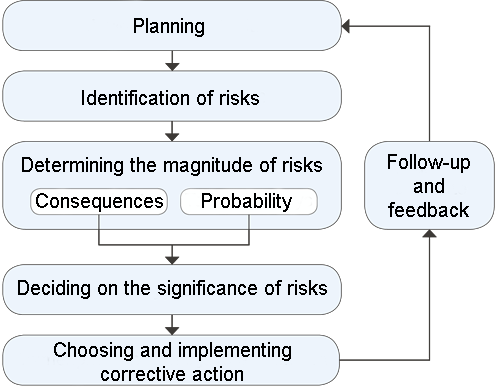

Safety and health in the workplace
Risk assessment
It is the duty of every employer to monitor the working environment continuously and consistently. In addition, the employer must identify the harms and hazards arising from the work and assess the risks to the health and safety of employees. This will allow the employer to find out whether there are deficiencies in working conditions that need to be corrected. Risk assessment is preemptive and always the most cost-effective approach.
General information on topic
The employer has a broad duty to take care of the health and safety of employees at work, based on the Occupational Safety and Health Act. Identifying hazards and harms is a part of this duty.
The employer is responsible for identifying and assessing the hazards, and they can choose a method that best suits the workplace. It is important to carefully plan the risk assessment and also to consider the organising of continuous monitoring and supervision of the working environment and the updating of the assessment.
Risk assessment requires the workplace management to commit to this by ensuring resources to carry out the assessment and to take action on the basis of the assessment. Employee participation is important, especially at the risk identification stage.
Risks to be assessed based on the severity and likelihood of the hazard
Before risks can be effectively managed, they must be identified and assessed. The extent of the risk is determined based on the severity and probability of the consequences. The more serious the consequence and the more likely the event, the greater the risk.
The employer must take control of the risks. This means that the risks are reduced to a level that fulfils the minimum requirements of laws and regulations on occupational safety and health and that the employee encounters as few risks as possible.
The employer must make the safety and health of employees a central principle in their operations. It is a good idea to create systematic and long-term operating methods for the workplace, linking occupational safety to workplace activities and work management systems. This way, occupational health and safety is included in everyday work.

Picture 1: Phases of risk assessment.
Instructions for employee
Please participate in assessing risks at your workplace if your employer so requests.
As an employee, it is your duty to immediately inform the employer and the occupational safety representative if you notice issues that cause a health or safety hazard at the workplace, for example:
- the physical working conditions (e.g. noise, indoor temperature, handling of chemicals, poor indoor air quality, lack of order or tidiness, or poor ergonomics)
- the psychosocial working conditions (e.g. unfair treatment, threats of violence, or excessive workloads)
- procedures
- machinery, tools and work equipment, or
- personal protective equipment.
You are also obligated to eliminate hazards in accordance with the employer's instructions when possible and safe. Even then, you must notify the employer and the occupational safety representative. In turn, the employer must inform you and the occupational safety representative of measures taken in the matter.
Instructions for employer
Each employer must be aware of factors that may cause employees to fall ill or have an accident. The risk identification can be assisted by the Workplace risk assessment workbook (pdf, in Finnish) and its forms, drawn up by the Ministry of Social Affairs and Health and The Centre for Occupational Safety. If the employer does not have sufficient expertise to carry out the assessment, an external expert (e.g. occupational healthcare) must be used.
If an issue that is clearly in contradiction with occupational safety regulations is detected during the risk assessment, it must be rectified immediately. If the identified risks cannot be eliminated immediately, the employer must assess their importance for the health and safety of the employees. On the basis of the assessment, working conditions must be improved, either by preventing the risks altogether or by reducing them to a tolerable level.
If the risk can be removed, for example, by means of a shield or similar technical arrangements, they must be used. In addition, the employer must provide employees with training and guidance on safe working practices, as well as tools and personal protective equipment.
The employer must also monitor the impact of the above measures on the health and safety of work and, if necessary, take further action. The employer must review the risk assessment in the event of a change in circumstances, and the assessment must always be kept up-to-date. It is recommended to review the risk assessment once a year.
If the employee informs the employer of a risk associated with work on their own initiative, the employer must always inform the employee and the occupational safety representative of the actions to be taken in the matter.
Legislation
Occupational Safety and Health Act (738/2002)
- Section 10 – Analysis and assessment of the risks at work
Government Decree on the Safe Use and Inspection of Work Equipment (403/2008, in Finnish))
- Section 4 – Assessment and elimination of risks
Government Decree on the Safety of Machinery (400/2008, in Finnish)
Government Decree on Chemical Agents at Work (715/2001)
- Section 6 – Identification of hazards and assessment of risks
Government Decree on the Selection and Use of Personal Protective Equipment (427/2021, in Finnish)
Government Decree on the Safety of Construction Work (205/2009)
Related topics in Tyosuojelu.fi
Glossary
This website is part of the European Commission's Your Europe portal. Did you find what you were looking for?


